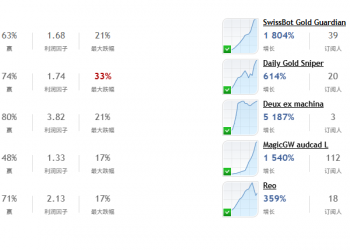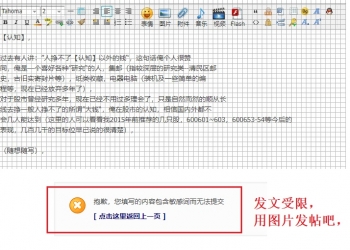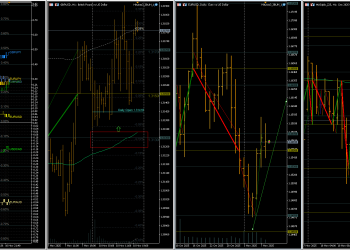第一套(用于中长线交易)
The Principles of Triple Screen
Triple Screen resolves contradictions between indicators and timeframes.
It reaches strategic decisions on long-term charts, using trendfollowing
indicators—this is the first screen. It proceeds to make
tactical decisions about entries and exits on the intermediate charts,
using oscillators—this is the second screen. It offers several methods
for placing buy and sell orders—this is the third screen, which we may
implement using either intermediate- or short-term charts.
Begin by choosing your favorite timeframe, the one with whose
charts you like to work, and call it intermediate. Multiply its length by
five to find your long-term timeframe. Apply trend-following indicators
to long-term charts to reach a strategic decision to go long, short, or
stand aside. Standing aside is a legitimate position. If the long-term
chart is bullish or bearish, return to the intermediate charts and use
oscillators to look for entry and exit points in the direction of the longterm
trend. Set stops and profit targets before switching to short-term
charts, if available, to fine-tune entries and exits.
SCREEN ONE
Choose your favorite timeframe and call it intermediate. Multiply it by
five to find the long-term timeframe. Let’s say you prefer to work with
daily charts. In that case, move immediately one level higher, to the
weekly chart. Do not permit yourself to peek at the dailies because this
may color your analysis of weekly charts. If you are a day-trader, you
might choose a 10-minute chart as your favorite, call it intermediate,
and then immediately move up to the hourly chart, approximately five
times longer. Rounding off is not a problem; technical analysis is a craft,
not an exact science. If you are a long-term investor, you might choose
a weekly chart as your favorite and then go up to the monthly.
Apply trend-following indicators to the long-term chart and make a
strategic decision to trade long, short, or stand aside. The original version
of Triple Screen used the slope of weekly MACD-Histogram as its
weekly trend-following indicator. It was very sensitive and gave many
buy and sell signals. I now prefer to use the slope of a weekly exponential
moving average as my main trend-following indicator on longterm
charts. When the weekly EMA rises, it confirms a bull move and
tells us to go long or stand aside. When it falls, it identifies a bear
move and tells us to go short or stand aside. I use a 26-week EMA,
which represents half a year of trading. You can test several different
lengths to see which tracks your market best, as you would with any
indicator.
I continue to plot weekly MACD-Histogram. When both EMA and
MACD-Histogram are in gear, they confirm a dynamic trend and encourage
you to trade larger positions. Divergences between weekly
MACD-Histogram and prices are the strongest signals in technical
analysis, which override the message of the EMA.
SCREEN TWO
Return to the intermediate chart and use oscillators to look for trading
opportunities in the direction of the long-term trend. When the weekly
trend is up, wait for daily oscillators to fall, giving buy signals. Buying
dips is safer than buying the crests of waves. If an oscillator gives a sell
signal while the weekly trend is up, you may use it to take profits on
long positions but not to sell short.
When the weekly trend is down, look for daily oscillators to rise,
giving sell signals. Shorting during upwaves is safer than selling new
lows. When daily oscillators give buy signals, you may use them to
take profits on shorts but not to buy. The choice of oscillators depends
on your trading style.
For conservative traders, choose a relatively slow oscillator, such as
daily MACD-Histogram or Stochastic, for the second screen. When the
weekly trend is up, look for daily MACD-Histogram to fall below zero
and tick up, or for Stochastic to fall to its lower reference line, giving
a buy signal.
Reverse these rules for shorting in bear markets. When trendfollowing
indicators point down on the weekly charts, but daily MACDHistogram
ticks down from above its zero line, or Stochastic rallies to
its upper reference line, they give sell signals.
A conservative approach works best during early stages of major
moves, when markets gather speed slowly. As the trend accelerates,
pullbacks become more shallow. To hop aboard a fast-running trend,
you need faster oscillators.
For active traders, use the two-day EMA of Force Index (or longer,
if that’s what your research suggests for your market). When the
weekly trend is up and daily Force Index falls below zero, it flags a
buying opportunity.
Reverse these rules for shorting in bear markets. When the weekly
trend is down and the two-day EMA of Force Index rallies above zero,
it points to shorting opportunities.
Many other indicators can work with Triple Screen. The first screen
can also use Directional System or trendlines. The second screen can
use Momentum, Relative Strength Index, Elder-ray, and others.
The second screen is where we set profit targets and stops and make
a go–no go decision about every trade after weighing the level of risk
against the potential gain.
Set the stops. A stop is a safety net, which limits the damage from any
bad trade. You have to structure your trading in such a way that no
single bad loss, or a nasty series of losses, can damage your account.
Stops are essential for success, but many traders shun them. Beginners
complain about getting whipsawed, stopped out of trades that eventually
would have made them money. Some say that putting in a stop
means asking for trouble because no matter where you put it, it will
be hit.
First of all, you need to place stops where they are not likely to be
hit, outside of the range of market noise (see SafeZone on page 173).
Second, an occasional whipsaw is the price of long-term safety. No
matter how great your analytic skills, stops are always necessary.
You should move stops only one way—in the direction of the trade.
When a trade starts moving in your favor, move your stop to a breakeven
level. As the move persists, continue to move your stop, protecting
some of your paper profit. A professional trader never lets a profit
turn into a loss.
A stop may never expose more than 2% of your equity to the risk of
loss (see Chapter 7, “Money Management Formulas”). If Triple Screen
flags a trade but you realize that a logical stop would risk more than
2% of your equity, skip that trade.
Set profit targets. Profit targets are flexible and depend on your goals
and capital. If you are a well-capitalized, long-term-oriented trader, you
may build up a large position at an early stage of a bull market, repeatedly
taking buy signals from the daily charts, as long as the weekly
trend is up. Take your profits after the weekly EMA turns flat. The reverse
applies to downtrends.
Another option is to take profits whenever prices on the daily
charts hit their channel line. If you go long, sell when prices hit the
upper channel line and look to reposition on the next pullback to the
daily moving average. If you go short, cover when prices fall to their
lower channel line and look to reposition short on the next rally to
the EMA.
A short-term-oriented trader can use the signals of a two-day EMA
of Force Index to exit trades. If you buy in an uptrend when the twoday
EMA of Force Index turns negative, sell when it turns positive. If
you go short in a downtrend after the two-day EMA of Force Index
turns positive, cover when it turns negative.
Beginners often approach markets like a lottery—buy a ticket and sit
in front of the TV to find out whether you have won. You will know
that you are becoming a professional when you start spending almost
as much time thinking about exits as looking for entries.
SCREEN THREE
The third screen helps us pinpoint entry points. Live data can help savvy
traders but hurt beginners who may slip into day-trading.
Use an intraday breakout or pullback to enter trades without realtime
data. When the first two screens give you a buy signal (the weekly
is up, but the daily is down), place a buy order at the high of the previous
day or a tick higher. A tick is the smallest price fluctuation permitted
in any market. We expect the major uptrend to reassert itself and
catch a breakout in its direction. Place a buy order, good for one day
only. If prices break out above the previous day’s high, you will be
stopped in automatically. You do not have to watch prices intraday,
just give your order to a broker.
When the first two screens tell you to sell short (the weekly is down,
but the daily is up), place a sell order at the previous day’s low or a
tick lower. We expect the downtrend to reassert itself, and try to catch
the downside breakout. If prices break below the previous day’s low,
they will trigger your entry.
Daily ranges can be very wide, and placing an order to buy at the
top can be expensive. Another option is to buy below the market. If
you are trying to buy a pullback to the EMA, calculate where that EMA
is likely to be tomorrow and place your order at that level. Alternatively,
use the SafeZone indicator (see page 173) to find how far the market is
likely to dip below its previous day’s low and place your order at that
level. Reverse these approaches for shorting in downtrends.
The advantage of buying upside breakouts is that you follow an
impulse move. The disadvantage is that you buy high and your stop is
far away. The advantage of bottom fishing is that you get your goods
on sale and your stop is closer. The disadvantage is the risk of getting
caught in a downside reversal. A “breakout entry” is more reliable, but
profits are smaller; a “bottom-fishing entry” is riskier, but the profits are
greater. Make sure to test both methods in your markets.
Use real-time data, if available, for entering trades. When the first
two screens give you a buy signal (the weekly is up, but the daily is
down), use live data to get long. You could follow a breakout from
the opening range, when prices rally above the high of the first 15 to
30 minutes of trading, or apply technical analysis to intraday charts
and finesse your entry. When trying to short, you may enter on a
downside breakout from the opening range. You could also monitor
the market intraday and use technical analysis to enter into a short
trade, using live charts.
The techniques for finding buy and sell signals on real-time charts are
the same as on daily charts, only their speed is much higher. If you use
weeklies and dailies to get in, use them also to get out. Once a live chart
gives an entry signal, avoid the temptation to exit using intraday data.
Do not forget that you entered that trade on the basis of weekly and
daily charts, expecting to hold for several days. Do not be distracted by
the intraday chop if you are trading swings that last several days.
[ 本帖最后由 bear 于 2005-10-10 17:11 编辑 ] |
 MQL5全球十大量化排行榜941 人气#黄金外汇论坛
MQL5全球十大量化排行榜941 人气#黄金外汇论坛 【认知】5288 人气#黄金外汇论坛
【认知】5288 人气#黄金外汇论坛 关于论坛修改用户名称的图解1053 人气#黄金外汇论坛
关于论坛修改用户名称的图解1053 人气#黄金外汇论坛 看涨欧元和英镑1099 人气#黄金外汇论坛
看涨欧元和英镑1099 人气#黄金外汇论坛